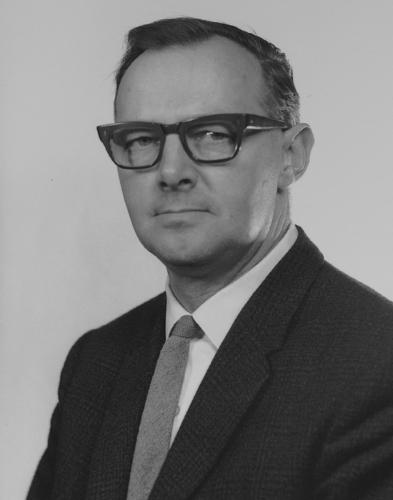 Bill Ellis, University of Tasmania, ca. 1970 (University of Tasmania photograph)
Bill Ellis, University of Tasmania, ca. 1970 (University of Tasmania photograph)
Graeme Reade Anthony Ellis
Contributed by Martin George
Graeme 'Bill' Ellis was born in Launceston, Tasmania, in 1921, and he was to become a major player in the development of low frequency radio astronomy. As early as 1949, Ellis, then a 27-year-old, was making radio observations of the Sun from Eaglehawk Neck in south eastern Tasmania during a partial solar eclipse. In the following years, while enrolled as a PhD student and working for the Ionospheric Prediction Service in Tasmania, Ellis performed important research on the ionosphere and this work eventually led to the award of his PhD degree in 1955.
Around this time, Grote Reber was taking an interest in low-frequency radio astronomy, and careful selection of an observing location was important because of the low-frequency cutoff caused by the ionosphere. Reber contacted Bill Ellis for information in early 1954 and, based on Ellis' encouraging reply, Reber decided that Tasmania would be the place to pursue low frequency radio astronomy research.
During 1955, not long after Reber's arrival in Tasmania, he and Bill Ellis were able to detect very long-wavelength radiation from the sky at frequencies down to about 1 MHz. Together they wrote a landmark paper entitled "Cosmic Radio-Frequency Radiation Near One Megacycle."
In 1960 Ellis accepted a position as Chair of Physics at the University of Tasmania, a position that he would hold for many years. Through his drive and determination, radio astronomy in Tasmania blossomed, and amongst his students were others who were themselves to become eminent in the field. By 1961 Ellis was doing a variety of experiments in Tasmania where he built several low frequency arrays operating between 2 and 20 MHz to map the southern sky at multiple frequencies.
In the mid-1960s Ellis received the Doctor of Science degree, based on his years of extensive research on the topics of ionospheric physics, the Earth's magnetosphere, low-frequency radio astronomy, and radio emissions from the planet Jupiter, which was a particularly favorite subject, as well as other celestial objects. Amongst his collaborators was Fred Hoyle, with whom he wrote a paper in 1963 proposing that the observed drop-off in the Galactic radiation below 5 MHz was due to an ionised layer within our Galaxy.
Bill continued his research through the 1970s and 1980s and this included the Sun and other celestial objects. Like so many others, he continued to work for some time after his official retirement, including his 1985 experiment with Grote Reber and others using the Challenger Space Shuttle in which the shuttle's engines were used to create a hole in the ionosphere through which very low frequency radio waves could be observed.
In 1963 Ellis was awarded the Thomas Ranken Lyle Medal - an award presented by the Australian Academy of Science for outstanding research accomplishments. In the following year he became a Fellow of the Australian Academy of Science, and in 1984, he was made an Officer of the Order of Australia.
Graeme ('Bill') Ellis passed away on 2011 February 4, aged 89.
![[IAU logo]](iau_wb_thumb.jpg)
![[URSI logo]](URSI-logo-thumb.jpg)
![[Karl Jansky at his antenna]](jansky_photo_02_thumb.jpg)
![[Reber's Wheaton antenna]](Reber_Telescope_Wheaton_thumb.jpg)
![[Dover Heights]](Dover_Heights_02_thumb.jpg)
![[4C telescope]](GB61-195_4C_telescope_thumb.jpg)
![[Ewen and horn antenna]](ewen_horn1s.jpg)
![[Dwingeloo, 1956]](Dwingeloo-1956-thumb.jpg)
![[Jocelyn Bell Burnell and Cambridge antenna used in pulsar discovery]](burnell2_thumb.jpg)
![[Lovell Telescope at Jodrell Bank]](site_1594_0001-500-334-20180316163019-thumb150.jpg)
![[Wilson, Penzias, and Bell Labs horn antenna]](wilson-penzias-horn_thumb.jpg)
![[6-m Millimeter Radio Telescope in Mitaka, Japan]](6m-thumb.jpg)

